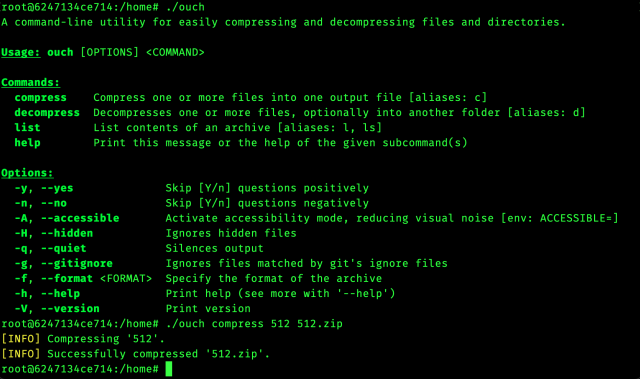A couple of command-line tools I’ve recently switched to using:
- yazi as file manager instead of lf (fast and, for me at least, more intuitive and better handles default editor)
https://terminaltrove.com/yazi/
- ouch for compression/decompression from CLI instead of getting the fucking unintuitive flags wrong every fucking time
https://terminaltrove.com/ouch/
(Thanks to @orhun for the recent link to Terminal Trove for the new finds.)
#cli #commands #utilities #commandLine #tui #terminal

ouch - Terminal Trove
Painless compression and decompression in the terminal - Discover more CLI and TUI tools like ouch and much more on Terminal Trove.terminaltrove.com

Brother Soul
in reply to Aral Balkan • • •I freaking so need to actually "Learn" Linux.
grrrrrrrrrrrr
Aral Balkan
in reply to Brother Soul • • •@brothersoul Just use it, it’s the best way to learn (and these tools are all available cross-platform so you can use them on a Mac, etc.)
And if you’re on Windows, you can always dip your toe in using WSL.
@orhun
Brother Soul
in reply to Aral Balkan • • •You rock for this m8.
Big Up's.
Brother.
Aral Balkan
in reply to Aral Balkan • • •PS. I’m running fish shell, so I also added a couple of abbreviations (I use abbreviations when I don’t want to type out the original command but I also don’t want to forget it):
abbr --add --global compress 'ouch compress'
abbr --add --global decompress 'ouch decompress'
Also note that Yazi has a function to let you switch to the folder you’re in when you exit:
https://yazi-rs.github.io/docs/quick-start
(I have regular Yazi aliased – in this case an alias makes more sense – to ff and the cd version to cc.)
Quick Start | Yazi
yazi-rs.github.ioRenoir Boulanger
in reply to Aral Balkan • • •one thing you can do is have a function to echo out the original command.
Typing the shortcut. You then see in STDOUT the command, and it’s execution output.
There has to be a way. Way back ago, I had this in my synchronized ~/.bashrc to all VMs I managed. Fish must have a way to achieve this with a few functions
JackTheSeparatistCat 🏴
in reply to Aral Balkan • • •evenreven
in reply to Aral Balkan • • •I finally memorised `tar xvfz` after 15 years of using Linux, are you telling me it was all for nothing?!
Love yazi, btw. I've gone from ranger to nnn to fff to lf to yazi, and yazi is my favourite so far.
yianiris
in reply to Aral Balkan • • •Have you tried nnn or even nnn-nerd
bash fish and zsh configurations built-in
@aral
Etienne
in reply to Aral Balkan • • •minimaxheadroom
in reply to Aral Balkan • • •Manage your Rust toolchain using rustup
Opensource.comAral Balkan
in reply to minimaxheadroom • • •minimaxheadroom
in reply to Aral Balkan • • •Distrobox
distrobox.itAral Balkan
in reply to minimaxheadroom • • •minimaxheadroom
in reply to Aral Balkan • • •Aral Balkan
in reply to minimaxheadroom • • •@minimaxheadroom Sure, it’s, e.g.,
distrobox-export --bin (which fastfetch) --export-path ~/.local/bin
(Replace fastfetch with whatever is the name of the binary you just installed.)
Cool thing about Rust apps is you don’t need this step. (Although you will need to specify the full path to them if using with sudo.)
On to your other question: I work exclusively within the host and only use a container to install/build stuff.
Jim Flanagan
in reply to Aral Balkan • • •